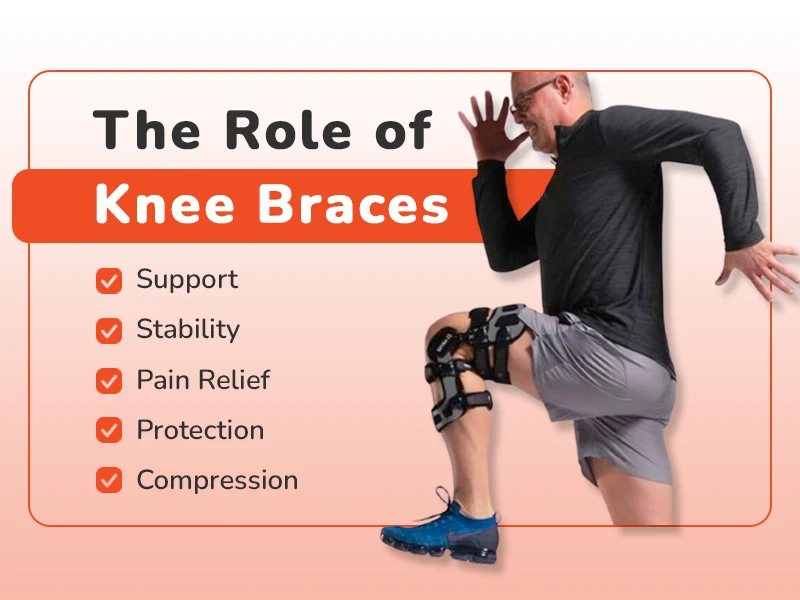Knee Braces: Support, Stability, and Recovery
Knee braces are more than mere medical devices; they are your trusted allies in the journey to better knee health. Whether you’re an athlete on the path to recovery from an injury or an individual coping with chronic knee pain, comprehending knee braces’ pivotal role in delivering support, stability, and aiding recovery is of utmost importance. In this all-encompassing guide, we explore the realm of knee braces, delving deep into the nuances of when and how to employ them effectively. So, let’s unravel the secrets to harnessing the full potential of knee braces and regaining control of your knee health.
Understanding Knee Pain
Before diving into the benefits of knee braces, it’s essential to comprehend the various factors contributing to knee pain. Knee pain can stem from a variety of causes, including:
- Injuries: Traumatic incidents like sprains, strains, or fractures can lead to acute knee pain, often requiring immediate attention.
- Arthritis: Conditions like osteoarthritis or rheumatoid arthritis can result in persistent knee pain and stiffness, affecting one’s quality of life.
- Overuse: Athletes and individuals engaged in repetitive motions may experience overuse injuries, putting additional strain on the knee joint.
- Degeneration: As we age, the knee joint may undergo degenerative changes, causing discomfort and hampering mobility.
Identifying the root cause of your knee pain is pivotal in determining whether a knee brace can provide the relief and support you need to regain control of your life.
The Role of Knee Braces
Knee braces are not mere orthopedic accessories; they are meticulously designed medical devices with a multifaceted role to play:

- Support: In ligament injuries or instability cases, knee braces step in as steadfast allies, offering vital support to the knee joint.
- Stability: They act as unwavering sentinels, ensuring the stability of the knee joint and transforming movements into safer, more controlled endeavors.
- Pain Relief: Knee braces hold the potential to diminish pain and discomfort, making daily activities and sports pursuits significantly more manageable and less strenuous.
- Protection: For individuals in the throes of post-surgery recovery or those convalescing from injuries, knee braces are vigilant guardians, shielding the knee joint against further damage or the peril of reinjury.
- Compression: Certain knee braces go above and beyond by providing compression, a feature that reduces swelling and inflammation.
Now, as we embark on this journey to delve deeper into the myriad benefits and types of knee braces, you’ll discover how these remarkable devices can be your staunch allies in enhancing knee health.
Types of Knee Braces
Knee braces come in various types, each designed for specific purposes:
- Knee Sleeves: These unobtrusive companions offer gentle compression and support, making them apt for minor knee discomfort or swelling.
- Hinged Knee Braces: Elevating the support game with their side-mounted hinges, these stalwarts are the go-to choice when contending with moderate to severe injuries or convalescing post-surgery.
- Patellar Stabilizers: Setting their sights on stabilizing the kneecap, these braces shine when confronted with conditions like patellar tracking disorder.
- Functional Knee Braces: Serving as post-injury or post-surgery sentinels, these warriors of the orthopedic realm deliver unparalleled support and stability.
- Prophylactic Knee Braces: Sporting a preventive caper, these braces are the darlings of athletes. They stand guard, particularly in high-impact sports, diligently curbing the risk of knee injuries.
The quest for the ideal knee brace pivots on a twofold compass—your precise condition and the level of support requisite. Consulting healthcare professionals can usher in informed decisions that align seamlessly with your requirements.
When to Use a Knee Brace
Deciphering the opportune moments for donning a knee brace is pivotal to efficient pain management and recovery. Delve into the following scenarios where adorning a knee brace can reap substantial benefits:

- Acute Injuries: In the aftermath of a sudden and intense injury, such as a ligament tear or sprain, the application of a knee brace serves to bestow stability upon the joint while concurrently fostering the healing process.
- Chronic Conditions: For individuals grappling with enduring knee afflictions like arthritis, knee braces emerge as steadfast allies. They play a pivotal role in mitigating pain and augmenting joint functionality.
- Repetitive Stress: Tasks that entail incessant knee movements can culminate in overuse injuries. Here, the strategic use of a knee brace arises as a preventive shield, thwarting the onset of such injuries.
- Post-Surgery: The journey of recuperation after knee surgery becomes significantly smoother and more secure with the fortifying presence of knee braces. They not only offer indispensable support but also expedite the healing trajectory.
- Preventive Measure: As a proactive stance against potential knee injuries, athletes and individuals traversing domains with knee injury risks often opt to wear knee braces during physical activities proactively. This preventive measure dramatically curtails the likelihood of injury occurrence.
By grasping the essence of these situations where knee braces are propitious, you can harness the power of this orthopedic aid to navigate the seas of knee health with heightened confidence and resilience. Nevertheless, remember to liaise with healthcare professionals to ascertain the most tailored knee brace strategies for your unique circumstances.
Using a Knee Brace Effectively
Unlocking the full potential of a knee brace hinges on mastering the art of its proper use. Here are some invaluable tips to ensure your knee brace serves you effectively:
- Correct Fit: The cornerstone of knee brace effectiveness is achieving the perfect fit. Abide by the sizing guidelines set forth by the manufacturer. Your brace should provide support without causing discomfort from being overly tight.
- Proper Positioning: Position your brace meticulously over the affected knee, ensuring it aligns seamlessly with the joint. This precision targeting enhances its supportive prowess.
- Duration Matters: Adhere diligently to the recommended duration of brace usage as prescribed by your healthcare provider. Remember, excessive reliance can weaken the knee muscles, so heed their guidance scrupulously.
- Maintenance Rituals: Safeguard your knee brace’s hygiene and your skin’s well-being by maintaining it cleanly. Uphold the care instructions thoughtfully provided by the manufacturer.
- Combine with Therapy: In many instances, the most fruitful results emerge when pairing your knee brace with a tailored regimen of physical therapy exercises. Collaborate with a healthcare provider or a physical therapist to craft a personalized exercise plan that harmonizes seamlessly with your brace usage.
By mastering these fundamentals, you can extract the utmost benefits from your knee brace, ensuring its longevity and its pivotal role in your journey to conquer knee pain and regain optimal knee health. As always, consult healthcare professionals for personalized guidance, as they possess the wisdom to tailor solutions to your unique needs.
Read More: Knee Braces: Enhancing Support and Streamlining Recovery
Benefits of Knee Braces
Knee braces stand as versatile allies in the journey of managing knee pain and enhancing mobility, offering a plethora of valuable advantages:
- Pain Reduction: With their targeted compression and steadfast support, knee braces diminish pain and discomfort, paving the way for a more comfortable daily life.
- Improved Stability: Elevating knee joint stability to new heights, knee braces transform mundane daily activities and sports into safer and more secure experiences.
- Faster Recovery: For individuals embarking on the path of recuperation after knee injuries or surgeries, knee braces play a vital role in the healing process by providing a protective shield around the joint.
- Enhanced Mobility: By improving mobility, knee braces enable individuals to uphold an active lifestyle while keeping discomfort and pain at bay.
By understanding the types of knee braces, when to use them, and how to wear them correctly, you can effectively manage knee pain, support recovery, and enjoy improved knee health. Always consult a healthcare professional for personalized advice and recommendations regarding knee braces.
Conclusion
Knee braces are not just medical devices but your companions for healthier, pain-free knees. Understanding when and how to use them effectively can make a difference in your knee health journey. Whether you’re dealing with an acute injury, chronic condition or looking to prevent future problems, knee braces provide invaluable support, stability, and pain relief. By recognizing the types of knee braces available, knowing when to wear them, and using them correctly, you can take significant strides towards improved knee health and enhanced mobility. Always consult a healthcare professional for personalized guidance, ensuring your knee brace choice aligns perfectly with your unique needs. Embrace better knee health today and continue enjoying the activities you love pain-free.



